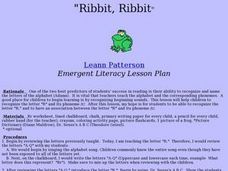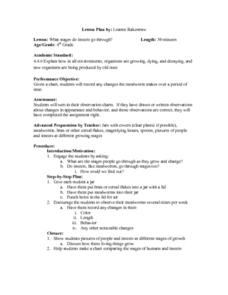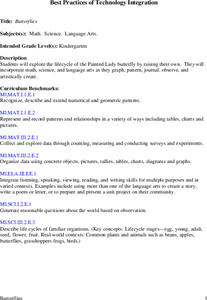Curated OER
Wigglers, Tumblers, & Bloodsuckers
Young scholars explore the life stages of a mosquito. In this animal biology instructional activity, students read Why Mosquitoes Buzz in People's Ears by Verna Aardema and complete several activities including an experiment with...
Curated OER
Life Processes
Students investigate the basic needs of organisms that must be met in order to carry out life processes. They view a variety of organism that are meeting and competing for resources. Students create an Idea Web for the animals shown....
Curated OER
Animal Habitats
In this animal habitats learning exercise, students study the 4 pictures of animals and habitats. Students draw a line to match the animals with their habitats.
Curated OER
Fall Lesson Plans
Students participate in various fall activities. In this fall lesson, students take a trip to a farmers market and purchase the ingredients needed for vegetable soup. Students paint fall scenes and create a fall story. Students discuss...
Curated OER
Why Is An Apple Like A Suitcase?
Students examine a variety of fruit to discover that each has seeds. Through experimentation, they discover the role that fruit and seeds play in a plant's life cycle.
Curated OER
The Very Hungry Caterpillar
Here is a good lesson on butterflies and caterpillars. After listening to The Very Hungry Caterpillar, young learners put cards that depict the life cycle of a butterfly in the correct order. There are some good ideas for center...
Curated OER
The Inside of an Apple
Students review the life cycle of apples before they study information about the inside of apples. They work in small groups to color and identify the parts of the inside of an apple. Finally, they use real apples to have an hands on...
Curated OER
Egg Story Mini Book
In this egg mini book learning exercise, students will color, cut out and collate pages to make a simple, picture mini book about the life cycle of a chicken.
Curated OER
Ribbit! Ribbit!
Learners research a frog's life cycle and habitat using books, the Internet and lecture. Students make origami frogs, write letters to Toad from Arnold Lobel's "Frog and Toad" and participate in a simulated camouflage activity.
Curated OER
Week 8 - Sea Life
Using a magnifier, mini marine biologists examine the barbules of a bird feather. They swirl the it into a mixture of oil and water and then re-examine the feather. After the activity, discuss how the oily feathers pose a problem to sea...
Curated OER
Oxygen-Carbon Dioxide Cycle
Fifth graders observe a diagram of the oxygen-carbon dioxide cycle to know that when they breathe out, they exhale carbon dioxide as do animals. They observe an aquarium containing both plants and fish and discuss the cycle. They then...
Curated OER
Strawberry Girl: Outdoors in Florida
Students explore nature by researching the state of Florida. In this animal identification lesson, students read a children' story and research the Internet to discover the difference in animal life between the early 1900's and present...
Curated OER
The Biological Carbon Cycle
Students learn about the biological carbon cycle. In this carbon cycle lesson, students access the web site and mouse over the diagrams to follow the carbon cycle. They read about what happens to humans and plants during this cycle.
Curated OER
Habitats
Students identify butterfly habitats. In this butterfly habitats lesson plan, students read and discuss Where Butterflies Grow. Students study pictures and guess which are butterfly habitats. Students list the life needs of butterflies...
Curated OER
Animals of Madagascar
Students are each assigned an animal from Madagascar. They research their animal and design a picture book about their animal. Students design a cover page, back page, bibliography page and the title page. Their book will contain...
Curated OER
Plants and Animals Depend Upon One Another
First graders study plants and animals and how they depend on one another. They also study that plants give energy to animals and provide oxygen needed for life. Finally, 1st graders give examples of the roles plants and animals play...
Curated OER
Teeth and Eating
Young scholars examine pictures of different animals and decide if they eat meat and/or plants. They inspect models of pairs of upper and lower teeth and discuss which teeth are most useful for cutting grass and tearing meat.
Curated OER
What Stages Do Insects Go Through?
Fourth graders observe mealworms over a period of time and record any changes they observe. They record any changes in color, length, behavior, and any other noticeable changes, identify the stages of the mealworms, and create a chart...
Curated OER
Plant Power
Here is an opportunity for your first graders to take a close look at plants: what they need to survive, how they grow, and the names of each plant part. The book, Corduroy's Garden is used to open the lesson. Then, youngsters utilize...
Curated OER
Are You Aware?
Bring the five senses to life with a fun science experiment! Kindergartners and first graders read an explanation of the five senses, then identify which items Sophia can sense if she is blindfolded. A science explanation at the bottom...
BBC
Ourselves
Young biologists identify parts of the body, sort humans from other animals, and list the difference they see. Learners are split up into groups of three, and each group must find pictures in magazines of humans and other animals. They...
Curated OER
Inside the Egg, Hatching Chickens
Students conduct an egg candling activity to show the life inside a fertile egg. Students discuss the needs the egg has of the hen, as well as similarities and differences between plants and animals. Students complete a life cycle wheel...
Curated OER
School Forest
Sixth graders explore the concept of biodiversity. In this biodiversity lesson, 6th graders discover a variety of planets and animals that live in forests, and how a rotting log benefits that environment. Students also locate seven...
Curated OER
Butterflies
Students will explore the life cycle of the Painted Lady butterfly by raising their own. They will incorporate math, science, and language arts as they graph, pattern, journal, observe, and artistically create.

























